Monday, 13 July 2009
NLCs over Thames Valley...
Noctilucent clouds put on a great show last night (July 12th). This was the view from my drive at around 10.30 BST, looking north-west.
I grabbed a series of shots through a Sony Cybershot on auto (camera on a tripod this time) and put two frames together in a mosaic to give the above panorama.
Through 10x50 binoculars, I was surprised at just how dynamic the tiny ripples and pulsations within the cloud filaments were. Movements could be seen quite easily. The display lasted until the early hours of the morning.
Tuesday, 16 June 2009
NLCs?
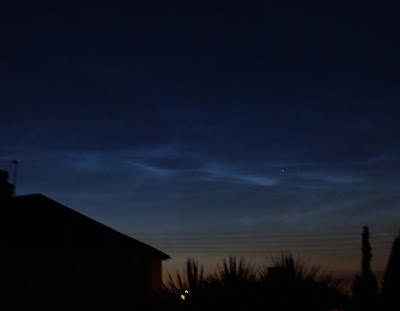
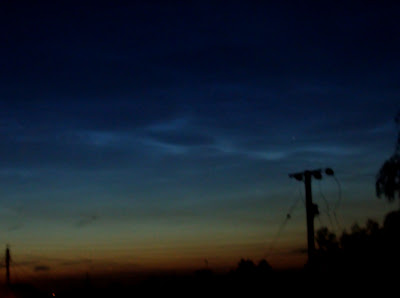
By the time I'd dashed downstairs to get a tripod for my camera, the display of luminous blue streamers had all but dissipated. If these were indeed the noctilucent clouds I've heard rumour of (and they look like it from the photos of others), this is the first time I've seem them for real.
Spooky. Beautiful.
Thursday, 28 May 2009
Messier 5...
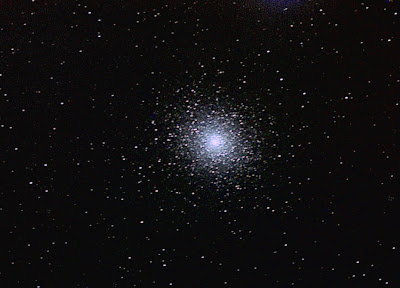 Click on image to enlarge.
Click on image to enlarge. Distance: 24,500 light years
Equipment: SXV-H9, Vixen ED 114mm aperture f5.3 refractor, ATIK manual filter wheel, Astronomix LRGB filters
Subframes: 20 x 60 seconds luminance (2x2 binned), 12 X 40 seconds each for red, green and blue channels, 16 flats/flat darks in luminance only, calibrated and stacked in AIP4Win, tweaked in AstroArt and PSP7.
From the same evening as the previous shot. As I started to image this at about 1.30 in the morning, M5 was already at only about 30° altitude and was starting to sink into the yellow fog of my western horizon.
Not surprisingly, it appeared a lot dimmer on the monitor screen than M3, even though in reality it's around half a magnitude brighter. This is definitely an object I need to revisit earlier in the evening to do it justice!
I was surprised at how blue this came up, even though it was processed in a pretty similar way to my earlier shot of M3. I don't know if that's just an effect of having to stretch the raws that much more to get rid of sky-glow.
With reference to my previous equipment glitch, David "Astroeyes" Moth (of galaxy imaging fame over on the UK SPA gallery site) has also had experience of SS2K crankiness. The connector between the handset and drives is definitely a piece of junk and lets the superb handset down. Both David and I have had the drive act randomly, and I have found I need to be careful not to have the connector under any sort of flexure. SS2K really is a wonderfully easy and powerful GoTo system and it's a shame that Vixen have superseded it with their SkyBook, which I don't care so much for. With SS2K, all the functionality is built in, without having to muck about with downloads, although I will admit things might have improved since I played with an early version.
As for my recent drive problem, I will have a look at the unit encoder - the behaviour does seem like the sort of thing that dust in an encoder might do.
Anyway.
Here's an earlier shot of M5 I took back in 2002:
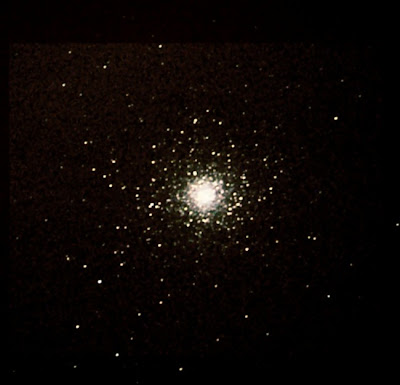
This was a single afocal frame using a Casio QV-3500Ex and my Vixen VC200L, which actually gives a good impression of what it looks like visually with the same scope under a good dark sky (of the sort I might get once every year if I'm lucky). As with M3, it comes up greenish, although Rob Gendler's work gives a blue colour similar to the one I obtained with the SXV-H9.
Wednesday, 27 May 2009
Messier 3...
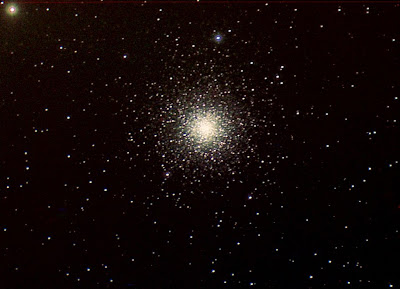 Click on image to enlarge.
Click on image to enlarge.Distance: 34,000 light years
Equipment: SXV-H9, Vixen ED 114mm aperture f5.3 refractor, ATIK manual filter wheel, Astronomix LRGB filters
Subframes: 20 x 60 seconds luminance (2x2 binned), 20 X 40 seconds each for red, green and blue channels, 16 flats/flat darks in luminance only, calibrated and stacked in AIP4Win, tweaked in AstroArt and PSP7.
This session did not start particularly well. My venerable Skysensor 2000 GoTo unit has been getting increasingly cranky with age, rather like its owner. This time, when asked to point towards Regulus for initial alignment, the RA drive gave out a strange mewling noise and refused to move. Switching everything off and on again didn't help.
However, when I aimed at Vega as the initial alignment star, everything worked fine. Arcturus and Spica gave me my usual three star alignment in no time. Trying to return to Regulus prompted the drive to sulk again, however.
Regulus is a perfectly respectable star of course, and there was no need for this sort of behaviour. As the time was now around 11 pm though, and with clear and reasonably dark skies overhead, I really didn't want to spend any time fault-finding. Fortunately, when I aimed at M3, the image fell on the CCD chip first time. Tracking wasn't so good, though. The drive seemed a touch jittery and the best I could do was 60 second exposures, even with the PEC running.
Nevertheless this is plenty for a bright globular like M3, provided you don't want to image too deeply. I was interested in a wide field view and was reasonably satisfied with the final result as above, once I processed all of the images and layered them together.
It was certainly an improvement on my first attempt some five years earlier (see below).

I took this afocally with my (now sadly deceased) Casio QV-3500EX digital camera at the eyepiece of my VC200L. It's a single one-minute exposure at ISO400. It's interesting how the colour of this digital camera shot was reflected in the composite from the mono camera above - I have a routine I use for colour compositing in PSP7 and it does seem to match "reality" (subjective though that is when it comes to colours of deep sky objects) quite well.
Rob Gendler shows us what careful processing of top-class images of M3 can achieve here. He also gives us a stack of useful information about this object here.
Once I acquired the frames I wanted for M3, I thought I may as well stay up for another couple of hours and try and catch M5, possibly my favourite globular to look at visually. I don't know how those frames have turned out yet - rigor computoris is setting in and so they'll have to wait.
Sunday, 29 March 2009
The Owl Nebula...
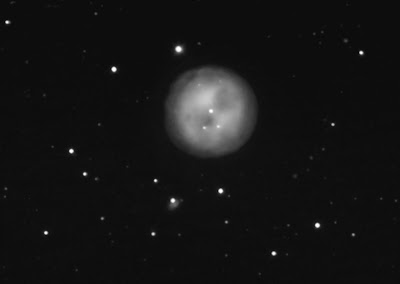 Click on image to enlarge.
Click on image to enlarge.Distance: 2600 light years
Equipment: SXV-H9, Vixen VC200L 200mm aperture f9 catadioptic, UV/IR filter
Subframes: 17 x 120 seconds (3x3 binned), 16 flats/flat darks, calibrated and stacked in AIP4Win, tweaked in AstroArt and PSP7.
Another clear but very windy night. I had previously used my 200mm Vixen 'scope to visually examine and sketch this object about five years ago. It was a stunningly dark and clear spring night, and the memory of being able to clearly see the "Owl's eyes" has stayed with me ever since then.
Such nights are a rarity in my little light-polluted corner of the world, and this plainly wasn't one of them. Try as I might, I couldn't even see the Owl at all. Indeed, I even had to resort to 3x3 binning to get a image I could see on screen via my CCD.
At a focal length of 1800mm, even my Vixen GPDX won't allow more than a couple of minutes unguided exposures. I have given up on trying to get my SXV-H9 autoguider to work. Despite some very helpful dialogue on the Starlight Xpress board, it's still no go. I thought my wiring was wrong but I've tried the cable with someone else's SS2K and it works. Clearly the fault is with my SS2K handset or the SXV itself - I need to check out my handset with my colleague's set-up...
Anyway, I spent about 30 minutes doing a drift alignment to get the tracking spot on. I usually shoot two minute frames and tweak the mount Alt/Az controls until no trailing is apparent. On this evening, the gusty wind was giving me all sorts of problems with both this and the PEC setting.
In the end, I got something I thought was about right, and went for 50x2 minute exposures at 3x3 binning - the image was so faint I reckoned the extra sensitivity would outweigh loss of detail, especially given the long focal length.
Needless to say, clouds rolled on halfway through the session. I got 37 subs in all, of which only 17 were usable thanks to the gusting wind. So I'm actually quite pleased with the result given the conditions and lack of subs, an image which shows the Owl's eyes reasonably well.
On my image I noticed a smudge of what seems to be nebulosity under the star (GSC catalog number GSC-3824-1065 I think, according to SkpMap Pro 9) just beneath the nebula at the 7 o' clock position. I initially thought that this was a processing artifact, but Johannes Schedler's much better resolved shot shows it as well. SkyMap Pro 9 doesn't show it - there's a galaxy (PGC 34279) indicated nearby, but not quite in the same position
Does anybody know if this star's beard has a designation?
Update: The helpful and knowledgeable folk on the SPA gallery forum have confirmed that my "mystery nebula" is indeed the 16th magnitude galaxy PCG 34279. It prompted me to have a play with using the SLOAN digital sky survey, which is an amazing resource to use. Click on the above link to the forum to see the discussion and links to the SDSS data.
Thursday, 26 March 2009
Messier 81 and 82...
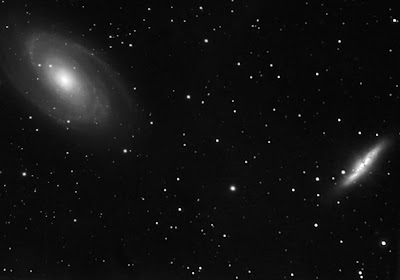 Click on image to enlarge: North is at 4 o' clock.
Click on image to enlarge: North is at 4 o' clock.Distances: 4.5 million light years (M81), 17 million light years (M82)
Equipment: SXV-H9, Vixen 114mm aperture f5.3 ED refractor, UV/IR filter
Subframes: 30 x 120 seconds 2x2 binned, no flats or darks, stacked in AIP4Win, tweaked in AstroArt and PSP7.
After nearly a whole month of haze and cloud, at last an opportunity to get some imaging in! I had caught M81 previously and had decided that I would like to get an image of M81 and its attendant "starburst" companion, M82, in the same frame, as the SXV-H9 chip size with my refractor was just about big enough.
This proved a little more tricky to frame than it looked. I'd also got a bit rusty on technique after nearly a month off! It took me a lot longer than usual to get the two galaxies framed, and I was conscious that my last few imaging sessions had been cut short by the appearance of clouds. In the end, I settled for the above, although my SkyMap Pro tells me I could have done a lot better by rotating the camera another 40 degrees or so.
I normally don't bother with dark frames as the SXV-H9 is pretty low on noise given the short exposure I normally use. Flats are, however, essential. However, on this occasion, I inadvertently took the camera off of the telescope when I finished the session. I normally always leave it on, so that I can shoot flats against a white screen in my garage next day.
I'd forgotten that part of my routine because of the weather-enforced layoff. Moving the camera in relation to the telescope obviously invalidates any flat-fielding, so I resorted to gradient and noise filters to hammer out backgrounds that would normally be handled by flats.
The resultant image isn't as detailed as I'd like, but it's not bad. One of these days I'll get a session in where I get everything right...
M81 seems pretty popular on the SPA gallery at the moment, so I haven't posted my effort because there are better ones on there already. I particularly liked Olly Penrice's shot, although he does enjoy dark skies deep in Southern France so he tells us, which is cheating really...
I'm only jealous...
Monday, 23 February 2009
Comet Lulin
Distance: 63 million km at time of imaging
Constellation: Virgo
Equipment: SXV-H9, Vixen 114mm aperture f5.3 ED refractor
Subframes: 6 x 60 seconds, 16 flats/flat darks, calibrated and stacked in AIP4Win, tweaked in PSP7.
Look out of kitchen window at 6 pm. Clear, dark, star-studded skies. Don cold weather gear, enter garage, set up equipment and wheel down to observing platform.
Look up in trepidation, given recent weather. Still clear, dark, star-studded skies.
Polar align, set up 3-star align on SkySensor. Not a cloud in sight. Feed in comet orbital parameters to SkySensor and hit GoTo. Comet smack in centre of field. Spend a few minutes looking at it visually and have to admit to being slightly disappointed, having seen images of it and foolishly expecting to see same at eyepiece. I could not really discern a tail, nor any colour in the coma. But a mag 6 comet of any sort is still pretty special and a little spooky.
Remove eye-piece, fit CCD camera. Spend a couple of minutes focusing and another 10 minutes running the periodic error correction to make sure tracking was even. Mistake to faff about with PEC...
Blobs of cloud now starting to blow over. Set up 20 x 60 second exposures on lap-top and hope for best. No chance. Haze already apparent. Six frames later, solid cloud.
Curse luck. Cover equipment with tarp and leave out, hoping skies might clear. They don't. Give up at midnight, switch everything off and wheel back in.
And that was Comet Lulin, that was - for me, anyway. Solid cloud or haze for the next few weeks over my swampy corner of the UK meant I never saw it again. I salvaged what I could and the result is above - the haze gave an impossible gradient and background to the few subs that showed anything, but the core and a trace of coma can be seen.
Some folk had a bit more luck, as can be seen here...
Saturday, 14 February 2009
The Cone Nebula...
Type: Cluster with Nebula
Distance: 2500 light years
Constellation: Monoceros
Date: 24 January 2009
Equipment: SXV-H9, Zeiss 135mm telephoto lens at f3.5, ATIK manual filter wheel, Astronomix H-alpha, green and blue filters
Subframes: 20 x 300 seconds in H-alpha, 10 x 300 seconds in green and blue (unguided, 2x2 binned), 16 flats/flat darks, calibrated and stacked in AIP4Win, colour channels merged in PSP7
I've had several previous attempts at imaging this area, each suffering from poor tracking or poor atmospheric conditions, or both. Once again, my luck was out on this one.
This time, I decided to shoot red (H-alpha), green and blue channels in a 2, 1, 1 rotation, just in case the clouds rolled in and stranded me with half the set of subs needed for a colour image. Sure enough, the miserable run of cloudy skies this winter relented only for a couple of hours before a high haze set in once more.
And once more, my tracking was a tad out, meaning I had to hit the frames with a deconvolution filter to round up the slight trailing on the stars. This leaves dark circles around the brighter stars and also costs some image detail. The Cone Nebula itself stands out quite nicely though, and the extent of nebulosity in the area surrounding the 'Christmas Tree Cluster' can clearly be seen, even if some of the detail is missing.
Still, I'll take what I can get given the weather. Lack of sunspots and cloud nucleation? Global warming meaning more haze at high latitudes?
Or just bloody British weather? It's all very frustrating...
Thursday, 29 January 2009
The "69" nebulae...
Object: IC 410 and IC 405 (The "Flaming Star" Nebula, Caldwell 31)
Despite an ever-increasing haze that cut short my imaging session for this one (hence only 5 blue subs in the end), I was reasonably pleased with the end result. I had planned to take loads more subs if the sky held but given recent history, I was glad I had decided to take a few subs through each filter in turn rather than long sessions through each one.
The channels were stacked in AIP4Win and assigned and aligned in PSP7. The final image was a touch noisy because of the small number of subs, but a quick pass with the freebie version of NeatImage did quite a reasonable job in cleaning it up.
As for the name I gave it, I was just surprised at how sharp the "small 6" of IC410 and "big 9" of IC 405 stood out on the H-alpha frame. The effect isn't quite so striking on the final colour version.
Maybe the final result maybe isn't as good as this one from Greg Parker's New Forest Observatory, but given my somewhat "lower budget" set-up (below), I think I've got value for money on this occasion - especially given the weather...
The shot above (click on the image for a clearer view) shows my current system for wide-field imaging. The equipment is all mounted on a Vixen plate, with the SXV-H9 clamped in a simple bracket made out of a bit of copper tube that I flattened down and drilled. This allows me to rotate the camera for image framing. The filter wheel and lens (with mandatory dew heater) sit on the camera: I've found the filter wheel leaks a bit of light so that's what the silver foil is for. An old Celestron 7 x30 finder is used for rough alignment, with the Vixen guidescope and reticule eyepiece that's above it being used for precise alignments.
It's a simple and robust set-up that stands up quite well to being bounced around on my gadget box when I roll it out of the garage.
Friday, 23 January 2009
Messier 45 - The Pleiades...
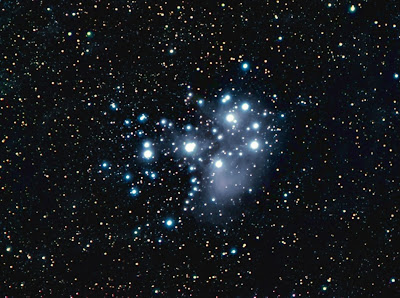
Type: Open Cluster
Distance: 407 light years
Constellation: Taurus
Date: 18 January 2009
Equipment: SXV-H9, Zeiss 135mm lens, ATIK filter wheel, Astronomix LRGB filters
Subframes: 30 x 300s full resolution subframes (luminance), 20 x 200s RGB 2x2 binned, 16 flats/flat darks (no darks) in luminance, channels calibrated and stacked in AIP4Win. Final processing in AstroArt and PSP7.
It really has been an exceptionally poor winter for imaging so far, has it not? On the few nights that stars are actually visible, there has been a mist lurking around, robbing the sky of any sort of clarity needed for deep-sky work. This particular evening was not really much better but it had been so long that I’d thought I’d give it a go on something bright, like M45, an object I’d never really had much luck in imaging in terms of capturing the delicate nebulosity that suffuses its stars.
Seeing started poor and a high haze became increasingly heavy during this imaging session. I shot what were going to be the luminance frames for the image (200s at full resolution through a UV/IR blocker) first, followed by the red and green frames at 2x2 resolution, and all the while the sky background on the images was getting brighter and brighter. When I finally shot the series of 200s blue frames, I was amazed at how burnt out the stars looked compared to the red and green channels – perhaps an indication of just how “blue” the Pleiades are (or perhaps the lens has a touch of chromatic aberration). I was going to shoot a series of frames at shorter exposures, but by then the stars were virtually hazed out, so I gave up.
The blue frames were a write-off, so I used the luminance channel as the blue one, and pieced together an RGB composite in Paint Shop Pro. This was a bit fiddley as I’d resized the 2x2 binned red and green channels in AIP4Win to match the full resolution luminance channels. In PSP, not only were those images very slightly smaller than the “unresized” ones, there was a bit of rotation as well, probably because I’d had to reverse the equatorial mount between the red and green frames.
The high haze had also caused some horrible gradients across the raw images, and the stacked ones took quite a bit of processing to flatten them out.
It was all a bit much for the AstroArt RGB processing package, which couldn’t stack the colour frames and introduced a load of new coloured gradients anyway, hence a bit of laborious trial and error work to rotate and resize the composites in PSP7 to get something that could be aligned accurately enough to avoid odd and unequal flaring effects on the stars.
With all of this heavy processing, the final image isn’t too brilliant. The brighter stars are still a bit burnt out – you can’t pick out the three small stars just west of Alcyone, for example, which the best shots can clearly resolve. The nebulosity around Merope and is also rather restricted and doesn’t show the “brush-strokes” you see in really good images of this area of the sky.
Whether that’s down to the poor conditions at the time, a poor processing technique and/or insufficient resolution from the 135mm telephoto lens, I’m not sure.
There are certainly better shots of M45 out there than this one. I think I’ll give up on it for now…







